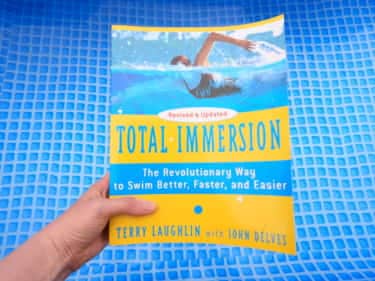Learning to swim has been one of the most rewarding things I have done and well worth the time and effort.
I learned to swim as an adult, and it took me a long time as, besides not knowing how to swim, I was afraid of the deep water.
To teach yourself swimming as an adult, the best method, and one I have used, is the total immersion swimming method. The total immersion swimming method is a swim coaching technique with lots of drills that will teach you how to swim efficiently and get you swimming quickly.
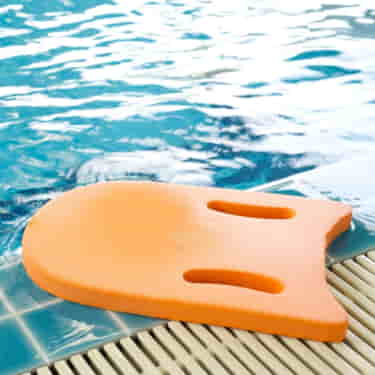
Like many children, I was sent to swimming lessons, and I hated them! The constant and tireless kicking with those kickboards and somehow, everyone else just seemed to move effortlessly in the water.
In addition, I had a fear of the water, which my swim coach did not handle well. Fear of water is one factor that makes learning to swim particularly challenging.
I had accepted that I would never be a swimmer.
However, I loved watersports (above the water, with a lifejacket!) and knew that if I wanted to get better at my watersport hobby and improve my water safety, I had to learn to swim.
In this article, I’m going to talk you through:
- The challenges of learning to swim
- The stages of teaching yourself to swim
- How long it takes to learn to swim
How Difficult Is Learning To Swim?
At first, I found it very frustrating to learn to swim as an adult, as many swim coaches use the same techniques that they use to teach children and, from my experience, that just does not work.
As a general rule, learning to swim is difficult, especially if you have a fear of water, as this needs to be handled in addition to learning the technique of swimming. However, if you are already water confident. learning to swim can be moderately difficult to easy, depending on your technique.
Factors that make learning to swim difficult are:
1 – Fear of the Water
Fear of the water can extend how long you take to learn to swim, as you must fight against the demons in your head. If you have a fear of the water, getting a one to one personal coach who understands your fear is very beneficial.
Even if you don’t get a coach, you may need someone with you to reassure you, talk you through how to learn to float and watch out for you to ensure you are safe. When we suffer from fear, we go rigid. In the water, we need to relax in order to float.
Start in the shallow end, lying on your back, getting used to the water splashing on your face and getting comfortable in the water.
2 – Swimming Coordination
Like riding a bike, there is some coordination in learning to swim. Getting the timing’s right between breathing, entering your hand in the water and pulling to stroke can take a bit of getting used to.
To deal with the coordination aspect of swimming, I used to repeat little mantras of instructions. This made learning to swim less difficult.
For example, to get my arms working well, I would repeat this mantra in my head:
“Enter Reach Extend Pull”
This meant, enter your arm to the water, reach your arm forward, extend your arm as far as possible, pull your arm back.
3 – Swimming Breathing
Learning to breathe and coordinating breathing with movement is difficult. This is one of the most difficult aspects of learning to swim.
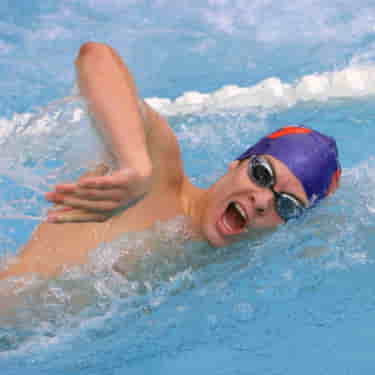
The only thing I have found that helps with my breathing was learning to swim with a swimming harness in a garden pool. This enabled me to focus on one aspect of swimming at a time, such as breathing techniques. I go into a lot more detail about swimming harnesses and their advantages and disadvantages in my article: What Is A Swim Harness? Examples included.
4 – Swimming Cardio Fitness
To swim well and long, there is a good deal of cardio fitness required. Fitness can be a barrier for some, making learning to swim more difficult.
The secret to dealing with poor cardio fitness when learning to swim is to relax in the water and focus more on gliding through the water than pulling. Let the water do the work.
Try to reduce your kicking, as this will make you tired quickly. If you want to learn more about kicking methods and tips, I’ve gone into a lot more detail in my article: How Much Should You Kick When Swimming?
5 – Cost
Learning to swim, be it self-taught or by a coach, can be expensive. Even if you are self-taught, you will need access to a pool. This can be one of the common barriers that make learning to swim difficult for so many.
Self-Teaching Stages In Learning to Swim
It is possible to self teach yourself swimming.
Below is the method I used to teach myself how to swim.
As mentioned, I had a fear of water, which added a whole new level of complexity to learning to swim.
If you have a fear of the water, I recommend hiring a swim professional for just one hour at least, to help you adjust to the water and teach you the basics of treading water.
By the end of your time with a swimming professional, your fear of water will still be present and you may feel like it was a waste of money, but swimming is about confidence and knowledge.
If you can gain water confidence and knowledge about the technique, you can self teach yourself to become an excellent swimmer.
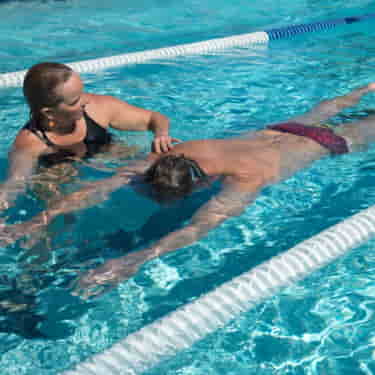
Stage One – Gain Water Confidence
It is important to become confident in the water.
To start with, turn up to your local pool and stay in the shallow end. Just get used to being in the water and water confident, moving through it even if that is just walking.
As a side note, walking through water is an amazing workout.
There are some basic drills and things you can do in shallow water to help you gain this water confidence:
Learn to Float – How do you teach an adult to float?
Floating is a great way to become water confident and an excellent skill to know. Plus, being able to float can save your life if you ever find yourself out of your depth in tricky water.
To learn to float, stay in the shallow end and lie on your back with your arms and legs out.
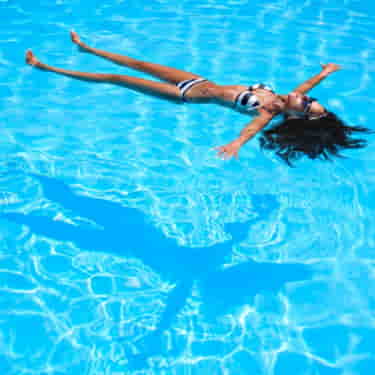
Here is a great video showing how to float:
Stage Two – Gain Fundamental Swimming Skills
Once you learn to float and you are relaxed in the water it is time to try some basic swimming skills.
The place where most adults start is learning to kick.
Learn to Kick
Kicking can be exhausting so don’t be discouraged if this is too difficult for you, just have a go. I was always terrible at kickboard drills, but I am glad I tried them just to get used to the water and kicking.
Get yourself a kickboard, hold it out in front of you and kick your legs.

You can do some very short widths of the shallow end of your pool, feeling what it is like to kick in the water and move through the water.
Here is a great video showing how you can use a kickboard.
Learn to Tread Water
Treading water is a fundamental swimming skill to learn, which often gets overlooked by professional swim coaches as it comes naturally to some swimmers. For me, this is something I had to work at.
Treading water is the ability to stay afloat in deeper water, typically in one spot without swimming.
There are a few methods you can learn to do this.
I was taught by a professional synchronised swimmer who showed me how to master the “eggbeater kick”. If you know anything about cooking and how an egg beater works, you might have already worked out the idea behind the name.
Many describe the eggbeater kick as the “breaststroke on your back”
Here is a video on how to tread water for beginners, using the eggbeater kick:
Learn to Use Training Fins
Discovering training fins was a significant breakthrough in my swimming journey.
Training fins are short flippers that are more suited to pool swimming. The extra length on your feet allows you to swim much faster, move through the water and gain water confidence.

I found the training fins particularly helpful as they gave me water confidence.
For the first time, I felt comfortable in the deeper water as the fins gave me the extra bit of strength in my legs. I suddenly felt like I was swimming with an outboard motor!
In addition, the training fins helped my technique as I learned what a “good” swim kick felt like. I learned how to move my legs to get the most propulsion.
Stage Three – Improve Your Swim Technique And Really Learn To Swim
Learn The Total Immersion Method
To get to this point in my self-taught swimming journey, which included dealing with my fear of water and learning a basic doggy paddle, it took about two years.
I must stress that most of my lack of swimming progress was because of a fear of the water and, honestly, just terrible advice. When you are not a natural swimmer, the typical “just swim a lot” advice is no good.
I then had a self-teaching breakthrough that made me into an excellent swimmer, and that was discovering the total immersion swim method.
The total immersion swim method is a swim teaching method that is ideal for a range of swim levels, from self-taught beginners to experienced swimmers.
The total immersion method focuses on technique. By following the total immersion swim method, I was swimming front crawl smoothly within one week. The week before, the best I could do was a doggy paddle.
The total immersion method explains how to move efficiently through the water and includes many drills that are easy for a self-taught beginner to try in the shallow end of the pool.
Here is the book I used to self-teach myself to swim, and I never looked back:
Total Immersion: The Revolutionary Way To Swim Better, Faster, and Easier
In addition to the book, they have a DVD which shows how to do the drills:

I am forever grateful to the creators of the total immersion swim method and if you are trying to self-teach yourself to swim; it is worth checking out.
If you want to ‘try before you buy’ the creator has loads of free tutorials on YouTube to get you started.
How Long Does It Take To Learn To Swim For Adults?
As a general rule, it can take between 1 month to 2 years to learn how to swim. How long it takes depends on factors such as fear of water, access to pools and ability to coordinate breathing and swim techniques.
It took me two years of regular swimming to learn how to swim, as I was terrified of the water.
However, once I learnt to cope with my fear of the water, it took me only one month to learn to swim using the total immersion swim method.
| Swimming Level | Average Time To Learn To Swim Well |
| Novice – with fear of water | 2-years |
| Novice – no fear – no technique training | 1-year |
| Novice – no fear – with technique training | 15-days to 1-year with the Total Immersion Method |
Am I Too Old To Learn How To Swim?
Swimming is a low-impact sport which makes it a fantastic sport to pick up as you age.
As a general rule, you are never too old to learn how to swim. In fact, swimming is a highly recommended sport as you age. Swimming is a low-impact activity that is light on our joints, plus learning swim techniques is good for cognitive function.
In addition to being a good activity for our joints and good for our brains as we age, swimming can also be a great social meeting place for adults to meet like-minded people.
There is no age limit to learning how to swim, so if it takes your fancy, take a dip!
Conclusion
It took me two years to learn how to swim.
For me, the hardest part was overcoming my fear of the water.
The significant breakthrough in my swimming came by discovering the total immersion swimming method. If you are trying to teach yourself how to swim, I really recommend looking this up or getting the book or DVD.
This swimming method changed my life and took me from being terrified of the water to swimming a mile a day without breaking a sweat.

